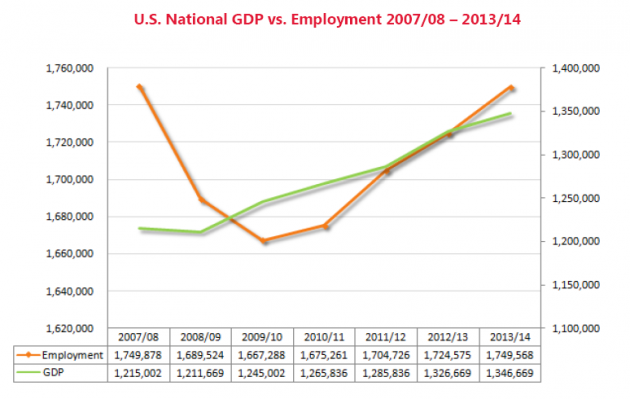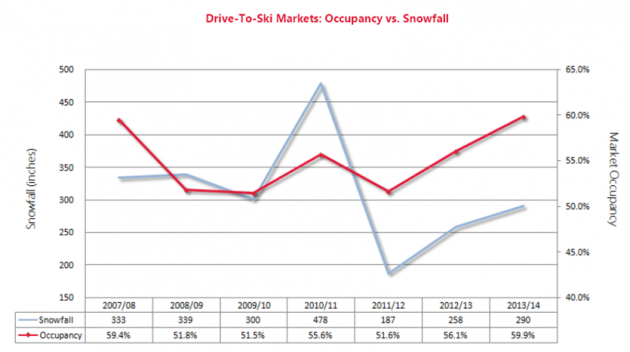By Brett Russell
January, 2015
Snowfall drives travelers to mountain resorts each ski season, but to what degree, at which resorts, and how far in advance isn’t as clear. What is the correlation between snowfall and hotel occupancy, and how does the economy factor in?
Many tourism and leisure hospitality markets depend in large part on environmental conditions to drive demand, with visitation up or down depending on whether certain conditions do or don’t exist. Hotels in tropical resort markets, for example, can depend on demand drawn to the sunshine and beaches–except in the midst of a hurricane or monsoon. Anomalous meteorological factors like heavy rains or storm winds may also affect travelers’ longer-term perceptions about a place, and this can negatively impact hotel demand.
Ski resorts face a similar situation, namely, how does a season’s snowfall impact visitation levels? The common assumption is that heavy snows mean more visitors, and it’s certainly true that when a winter storm approaches, eager skiers check their phones for how much new powder will fall at their favorite resort. But how far does the effect extend? Can one season’s bounty of snowfall stimulate bookings into the following year?
How Snowfall and the Economy Impact Occupancy in Destination Ski Markets
Mountain resort destinations like Wolf Creek, Loveland, and Breckenridge (Colorado); Jackson Hole (Wyoming); and Brighton and Snowbird (Utah) have made national headlines for receiving huge snowfalls—more than 400 inches over the course of one season. By contrast, drought has resulted in a dearth of snowfall at California ski destinations, and Lake Tahoe received only 180 inches last year.
The correlation of snowfall totals and hotel occupancy levels in eight western U.S. ski markets reveals some interesting patterns.
The above chart shows ski season occupancy versus snowfall in four destination ski markets (Telluride, Colorado; Aspen, Colorado; various Lake Tahoe-area resorts; Jackson Hole, Wyoming) from 2007 through 2014.
The four resort destinations featured in the chart are relatively remote, reached only by plane or a more than five-hour drive. These resorts typically have more than 60% of skiers coming from outside their home state or more than six hours away; hence, it’s highly likely that these skiers will take advantage of local accommodations at or near the resort.
Snowfall in these locations has seen some major swings, with 400 inches or more during two ski seasons and fewer than 300 during two others. Hotel occupancy in these markets varied too, but not as dramatically. In general, though, both snowfall totals and occupancy levels experienced a similar progression of peaks and valleys, all in the same year. This suggests that the booking windows are more short-term, which makes it difficult to cite snowfall as a presage to hotel bookings in the next season.
Furthermore, the occupancy decline of nearly ten percentage points from 2007/08 to 2008/09 was wreaked more by the recession than by a slightly lesser amount of snow. The chart below illustrates the course of national Gross Domestic Product (GDP) and employment levels, fiscalized starting in November, from 2007 through 2014.
The bump in occupancy at destination resorts in the 2010/11 ski season—when the economy and employment remained in a rut—could be attributed to the increase in snowfall. Still, the gain amounted to less than two points. Hence, while snowfall in a given season helps to improve occupancy levels at destination resorts, the impact seems minimal and limited to the same ski season. In other words, when it comes to hotel bookings at these and similar resorts, economic conditions have a greater impact than how much snow falls.
Drive-To Ski Resorts: Does the Same Hold True?
“Drive-to” ski resorts, defined as those relatively near major cities and easily reached in a matter of hours by car, have many of the amenities and services of destination resorts. Drive-to resorts, however, capture most of their demand from a more local market area, such as the Denver Metro area for Front Range ski resorts, or the Salt Lake City Metro area for resorts in Park City. Some of these drive-to resorts double as major destinations, with demand coming from farther off, but around 60% of visitors come from within the region.
The following table details hotel occupancy and snowfall totals in four drive-to ski markets (Breckenridge, Colorado; Vail, Colorado; Keystone, Colorado; Mammoth Mountain, California) from 2007 through 2014.
Data for these drive-to markets show more symmetry in terms of hotel occupancy and snowfall. Again, the pattern seems to be within a given season, but gains and losses in occupancy are over five points, depending on that season’s snow totals. Similar to the destination resort markets, drive-to markets were negatively impacted during the 2007/08 and 2008/09 seasons, which coincided with the recession. Unlike the destination markets, however, occupancy in drive-to markets recovered more quickly and has since surpassed pre-recession levels.
Conclusion
This analysis of ski resorts in the western U.S. suggests that snowfall totals have a more direct impact on drive-to resorts, while destination resorts are more heavily impacted by economic conditions. Surprisingly, one season’s snowfall totals do not seem to impact hotel occupancies in the following year at either type of resort market. Nevertheless, especially against the backdrop of a strong economy, it’s clear that a good amount of fresh powder allows for hotel occupancy in these markets to recover.




